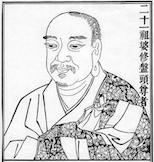Koso Wasan 11
Shakyamuni's teachings are numerous,
But Bodhisattva Vasubandhu compassionately urges us,
Who are possessed of blind passions,
To take refuge in Amida's universal Vow.
Brothers

It is not possible to tell the story of Vasubandhu without talking about his brother, Asanga. Asanga was the oldest of three brothers - the sons of a Brahman priest - who were born and raised in the Purushapura (now, Peshawar in northwestern Pakistan) the capital of Gandhara. Gandhara was a cradle of Buddhist civilisation. It was located in the Vale of Peshawar, extending into the lower valleys of the Kabul and the Swat rivers. It was known throughout the civilised world, and was at crossroads which afforded an exchange of ideas along with trade from India, Central Asia and the Middle East. The Mauryan dynasty reigned there from the time of its conquest by Alexander the Great in the 4th Century BCE. Greek rule followed and then a series of conquests by peoples from the north. During this time it was a hub, from which the Buddha Dharma radiated westwards and north to the Pamirs and into Central Asia. The pinnacle of its life as the centre of northern Buddhist civilisation was between the 1st and the 7th Centuries.
It was in Gandhara that there are reputed to have been exchanges between Greek and Indian philosophers but the most certain and marked contribution of Gandhara to Buddhist civilisation was Asanga and his brother Vasubandhu, along with the rising tradition of Buddhist sculpture and art; famous for its obvious Greco-Roman influences. It is worth noting that Buddhist archæologists are, even now, beginning to make remarkable strides in discovering just what kind of society and culture thrived in Gandhara. It is being found to have nurtured so much that gives the east Asian Buddhism its colourful, vibrant, elegant, deeply wise and compassionate character.
Into this wonderful civilisation Asanga and, later, his brother Vasubandhu were born. Both were 'serial converts', first joining the Sarvastivada order as a monk. It seems that Asanga was the first of the two brothers to find that the rigidity, literalism and 'realism' of the Sarvastivada was a block to his spiritual progress. Taking up the works of the teacher Maitreyanatha (who lived between about 275 and 350 CE) Asanga began to develop a philosophical and metaphysical basis for the practice of mental absorbtion (Sk. dhyana), which came to be known as Yogacara or Vijñanavada. Asanga's main contribution was the further development of Maitreyanatha's analysis of the 'storehouse' consciousness (Sk. alaya vijñana). These insights, which enabled a greater understanding of mental absorbtion and the process of its maturation, were important for monks whose course of study focused on meditation.
Having found that his spiritual life was deepening and becoming enriched in the context of the Mahayana approach to the Buddha Dharma, Asanga prevailed upon his brother Vasubandhu to join him in his studies in a different monastic order and he soon succeeded in convincing Vasubandhu of the virtue in such a change. Vasubandhu went on to offer many important contributions, not just to the Buddha sasana but to Indian culture in general. His most important contribution was the refinement of classical Indian syllogistic logic in which he delineated the procedure for reaching inferences in formal debate (which was in five steps) from the method we use in internal reflection (three steps), the personal thinking processes.1 From this he went on to compose Sastras based on his insight to the effect that all apparently external objects are really only mental constructs - a quite compelling theory of cognition.
The profound contribution to Buddhist life which Vasubandhu made - and which is evident in all Buddhist thought - would not have occurred without the influence and inspiration that came in his relationship with his brother Asanga. In this relationship we have an enduring model for the way in which the spiritual life of Buddhists is nourished and nurtured. Rather than in slavish obedience to authority and unquestioning acceptance of the claims of a teacher or guru, spiritual development in the dharma is relational and may come from any quarter; as in the natural relationshp between these brothers.
Shinran Shonin was a strong advocate of a fraternal relationship within the life of the dharma and encouraged his fellow followers to be aware that we all have a mutual teaching obligation; one that prevails between all men and women (on dobo, dogyo) who indentify themselves with the dharma community. In reality there are no formal teachers. We all support and nurture each other. A 'good friend of the way' (zenchishiki) is anyone with whom we come into contact - family member, spouse, friend or stranger - and who inspires us to put our trust in Amida Buddha.
1: See An Introduction to Mahayana Buddhism, With Special References to Chinese and Japanese Phases, William Montgomery McGoverm, 1922, pp.33-47: Epistemology and Logic.